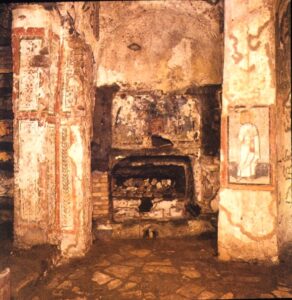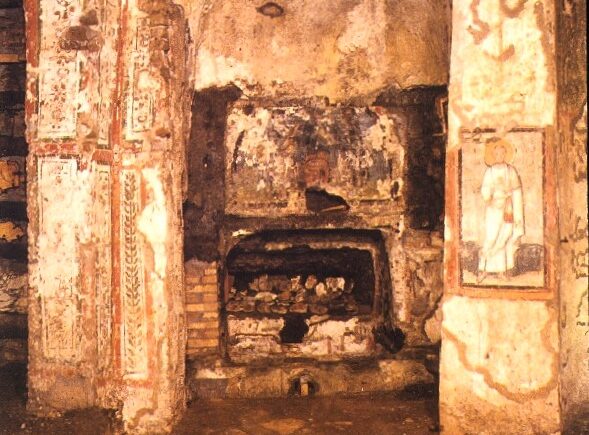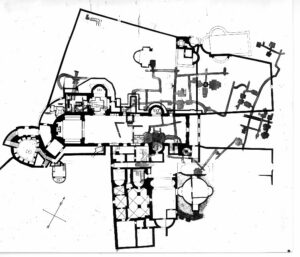Excerpt from: Estelle Shohet Brettman, Vaults of Memory: The Roman Jewish Catacombs and their Context in the Ancient Mediterranean World, with Amy K. Hirschfeld, Florence Wolsky, & Jessica Dello Russo. Boston: International Catacomb Society, 1991-2017 (rev. 2024).
The term "catacomb" is commonly used to describe a subterranean cemetery area of interconnected tunnels and chambers. It is believed to derive from the Greek "kata kumbas" ( = Latin, "ad catacumbas," or "near the hollows"). The expression originated as a topographical reference to a low area of land between the second and third milestones of the Appian Way outside of Rome. The burying ground in this site dates from at least the first century CE. It lay in a deep hollow, marked by the cliffs of a quarry for pozzolana left partly open to the sky and partly dug as a tunnel underground, providing space for various types of burials.[i] In the second half of the third century CE when, according to archaeologist Pasquale Testini, the site could have been "penetrated" by Christianity, it became a center of veneration of the apostles Peter and Paul, whose corporeal remains are believed to have been translated to that location from the Vatican and Ostia burying grounds during the persecution of Christians by the Emperor Valerian in 257.[ii]
In the fourth century, a funerary hall was built over the cemetery as a memorial or sanctuary for the cult of the two saints, known in contemporary sources as the Basilica Apostolorum.[iii] When the remains of St. Sebastian were buried in the crypt below this church, it was renamed for him, and his shrine and those of other Early Christian martyrs in the site continued to be visited by pilgrims throughout the Middle Ages. The site's continued accessibility over the centuries, and its special sanctity as a memory to Saints Peter and Paul, is likely what led to the term catacomb's being applied to all such subterranean cemeteries, be they private or communal.
The devotion to the memory of the Christian martyrs, as well as the impression made by the catacombs on the sensibilities of the Christians of the late fourth-century Rome, were expressed in the words of the scholar (and later saint) Jerome (ca. 350-420):
"When I was a youth at Rome, studying liberal arts, it was my custom on Sundays… to visit the sepulchers of the apostles and martyrs. And often did I enter the crypts, dug in the depths of the earth, with their walls on either side lined with the bodies of the dead, where the darkness was such the psalmist's words were fulfilled: 'Let them go down quick (alive) into hell'. Here and there a ray of light... filtering down as in a funnel relieves the horror of the darkness. But again, cautiously moving forward, the impenetrable night engulfed me, and I was reminded of the words of Virgil: 'Everywhere dread fills the soul; the very silence dismays."[v]

Fig. 2. General view of the central tomb of the two martyrs, Saints Felix and Adauctus in the Catacombs of Commodilla in Rome. The two saints are portrayed on the central tomb. To the right, St. Luke is portrayed with a bag of surgical instruments on his arm. The fresco dates from 668-685 CE. DAPICS n. 0938.
[i] P. Pergola, Le catacombe romane, (Rome: Carocci, 1998), pp. 22; 181-185. Fr. Antonio Ferrua proposed an original theory suggesting that the site's name might have originated from either a signboard of a nearby inn called "Ad Cumbas" (meaning "near the small boats") or a relief depicting two or more little boats. For further details, see A. Ferrua, The Basilica and Catacombs of Saint Sebastian, (Vatican City: Catacombe di Roma e d'Italia, 1978), p. 7.
[ii] P. Testini, Le catacombe e gli antichi cimiteri cristiani in Roma, (Bologna: Cappelli, 1966), pp. 216-218; 221.
[iii] It is traditionally believed that the site ad catacumbas was associated with the apostles because, during the persecutions of Valerian in 257 CE, their bodily remains were removed from the necropolises on the Vatican Hill and via Ostiense, where they had been buried, and reburied at the via Appia site for safety. Records indicate a celebration of their cult there on June 29, 258. In the fourth century, their bones were returned to their original graves; see M. Guarducci, The Tomb of St. Peter: The New Discoveries in the Sacred Grottoes of the Vatican, (Vatican City: Reverenda Fabbrica di San Pietro, 1960), pp. 25-26; P. Pergola, Le catacombe e gli antichi cimiteri cristiani in Roma, (Bologna: Cappelli, 1966), pp. 184-185; J. Stevenson, The Catacombs: Life and Death in Early Christianity, (Nashville, TN: Thomas Nelson, 1985), p. 32.
[iv] One notable exception to the above-described origins of catacomb names is that given to the cemetery of Calixtus, named after the site overseer, later pope; see J. Stevenson, The Catacombs: Life and Death in Early Christianity, (Nashville, TN: Thomas Nelson, 1985), p. 25..
[v] J. N. D. Kelly, Jerome: His Life, Writings, and Controversies, (New York: Harper & Row, 1975), p. 22; Ps. 55:15; Aeneid 2, 755.

